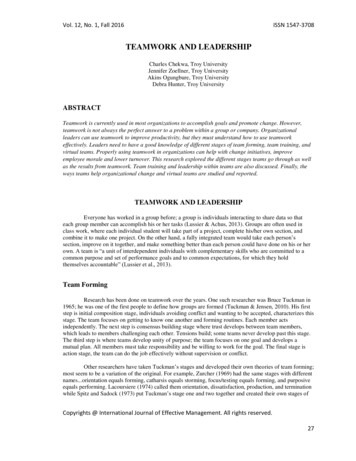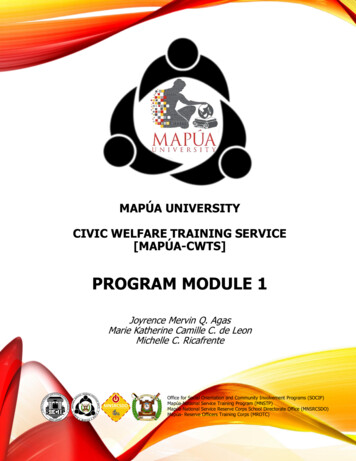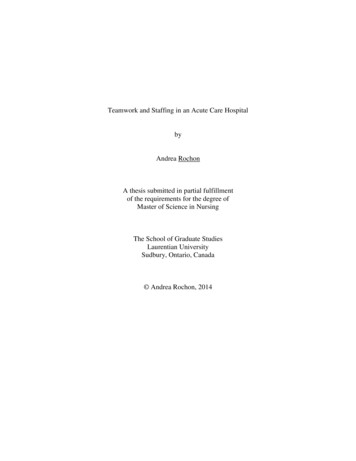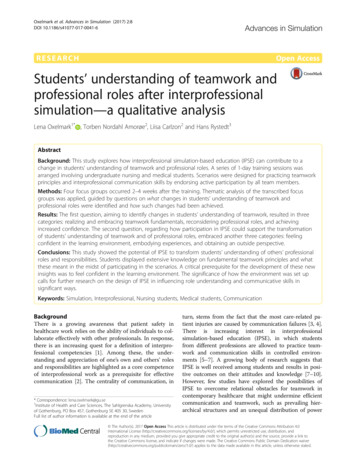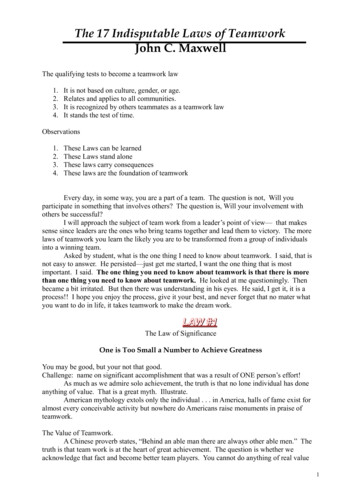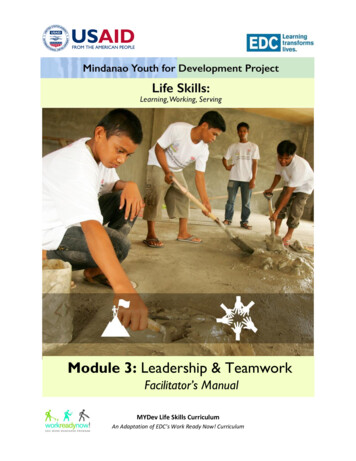
Transcription
Module 3: Leadership & TeamworkFacilitator’s ManualMYDev Life Skills CurriculumAn Adaptation of EDC’s Work Ready Now! Curriculum
Module 3: Leadership & TeamworkFacilitator’s ManualModule 3: Leadership & Teamwork“Ang mga lider ay tinuturing na huwaran.”Leaders are always taken as role models.Leadership ObjectivesBy the end of the module participants will: Define the qualities of an effective leader Identify some of the characteristics and behaviors of an effective leader Clarify their own leadership styles Apply cooperation skills to work effectively in a team Motivate and organize others Describe steps for problem solving and decision makingModule Overview Activity Time Session 1: We Are All Leaders2 hr 10 min1: Introductory Activity & Learner’s Reflection2: Leadership Styles55 min1 hr 15 min Session 2: Leading Teamwork / Group Cooperation1 hr 30 min3: Introductory Activity4: Floating Stick – Working Together25 min1 hr 5 min Session 3: Problem Solving & Decision Making1 hr 30 min5: The Human Knot – Group Problem Solving6: Problem Solving Steps50 min40 min Session 4: Task Leadership2 hr 20 min7: Task Leadership Competition8: Module 4 Review and Application1 hr1 hr 20 minTotal Time: 7 hr 30 minMindanao Youth for Development Project Life Skills Curriculum, adapted from EDC’s WRN! Curriculum 2016 Education Development Center, Inc. All Rights Reserved.Page 2
Module 3: Leadership & TeamworkFacilitator’s ManualModule 3 Materials and Preparations Basic training materials: manila paper, markers, tape, A4 paper. Make sure participants have their Participant’s Handbook available.Session 1: 1 paper ball Learners’ Reflection Prepare a manila paper with the proverb (below) to discuss with learners Review objectives of the module 1 rope (or a chalk to draw on the floor) Handout 3.1: What Makes a Great Leader? Make 1 copy of Facilitator Tool 3.A: Cut-Out Page Leadership Styles , cut out theleadership styles and fold them in half before the activity Handout 3.2: Leadership StylesSession 2: 1 paper ball Review materials for the session Collect 3-4 long sticks beforehand (approx. 3 meters long each) (one for each group of 8-10learners) Handout 3.3: Cooperation and Leading TeamworkSession 3: 1 paper ball Review the instructions to give to participants and the debriefing questions Handout 3.4: Problem Solving Steps and Tips Handout 3.5: Scenarios for Problem Solving StepsSession 4: Gather as many handkerchiefs as needed (or other cloth) for the blindfold activity Pepare a whistle or a bell (if avaialble) to use for the activities. Handout 3.6: Team Task List Prepare 3 statements that represent main topics learned in this module, printed them, andcut each one into a 3-4 piece puzzle (see step 1). Prepare a set of all 3 puzzles for each ofthe 3 group. Review topics covered in the module Prepare a prize for the best presenstantion of the application of learningMake 1 copy per participant of the End-of-Module AssessmentMindanao Youth for Development Project Life Skills Curriculum, adapted from EDC’s WRN! CurriculumPage 3 2016 Education Development Center, Inc. All Rights Reserved.
Module 3: Leadership & TeamworkFacilitator’s ManualSESSION 1: WE ARE ALL LEADERS Activity 1: Introductory Activity & Learner’s Reflection Objectives – By the end of the activity, participants will be able to:a.b.c.d.Review the main concepts of the previous module (Work Habits and Conduct)Identify the topics that are important for leadership and teamworkWork well in a teamIdentify the different roles people may play in a team Time Required: 55 minutes Methodology: large group discussion and activity Materials and Preparation: 1 paper ballLearners’ ReflectionPrepare a manila paper with the proverb (below) to discuss with learnersReview objectives of the module1 rope (or a chalk to draw on the floor)Steps:1. Welcome participants to Module 3 and quickly review some of the key points on WorkHabits and Conduct covered during Module 2. Have participants pass a paper ball. Theperson who catches it has to give an example of how they have used what they learned(wrote CV & application letter, had an interview, are improving their time managementskills or balancing work and family life better, etc.)(5 min)2. Ask participants to think about the proverb found at the beginning of Module 4: “Angmga lider ay tinuturing na huwaran” (Leaders are always taken as role models). Whatis the meaning?Explain that this module will focus on leadership and teamwork. Ask them what theythink the relevance is between the proverb and the module. How does it relate to reallife? Stress that we are all leaders in some way or another, either at work or in ourpersonal lives. The first session will cover leadership styles. State the main Key Topics ofthis session (below).(10min) Key Topics Leadership qualitiesLeadership stylesMindanao Youth for Development Project Life Skills Curriculum, adapted from EDC’s WRN! Curriculum 2016 Education Development Center, Inc. All Rights Reserved.Page 4
Module 3: Leadership & TeamworkFacilitator’s Manual3. Have learners take the Learner’s Reflection in their Participnat’s Handbook. Explainthat this is not a test but is a way to see what they already know or do not know aboutthe topics.Explain the meaning of each column (1, 2, 3, 4). Tell them that you will read a fewstatements. For each statement they need to check the column that best describesthem. Stress the importance of answering honestly and independently.Read one statement at a time and allow time for learners to think of an answer.(15 min)4. Set a relaxed tone by doing the following energizer called All Aboard: Draw a large circleon the floor (could be with chalk or a rope in the shape of a circle). Ask all participants tofit into the circle. Reduce the size of the circle after every successful attempt and havethem try to fit in it. Keep reducing the circle size until it is really impossible for all to fit in.(Encourage them to be creative by standing on one foot, lifting people, etc.). Explain thatworking well as a team and having good leadership activities help groups to do thisactivity successfully.(15 min)5. Debrief together.(10 min)Debriefing Questions:a. How do you find the activity? What was easy and what was difficult in this activity?(It was increasingly difficult as the circle became smaller. Learners may say thatit was difficult to agree on what to do, to find ways to fit in the circle, etc.)b. What are things that you did as a group that helped you find a way for everyone to fitin the circle?(Stepping on each other’s feet to save space, lifting people, laying down on thefloor, etc. It is very important to cooperate with others in the team.)c. What were some of the roles you saw people playing in this activity?(Some gave ideas, others just told people what to do, a few were deciding howto fit in the circle, others were following what the few said Some roles werethat of a leader – collecting ideas, helping choose the idea, and helping thegroup try out that idea, or think of other idea, until the task is accomplished.)Mindanao Youth for Development Project Life Skills Curriculum, adapted from EDC’s WRN! Curriculum 2016 Education Development Center, Inc. All Rights Reserved.Page 5
Module 3: Leadership & TeamworkFacilitator’s ManualMindanao Youth for Development Project Life Skills Curriculum, adapted from EDC’s WRN! Curriculum 2016 Education Development Center, Inc. All Rights Reserved.Page 6
Module 3 : Leadership & TeamworkFacilitator’s ManualLearners’ Reflection: Module 3 Leadership & TeamworkThere are no right or wrong ways to answer this survey. It is for your own use during this course. The facilitatorwill read a skill that is listed in the left column. Think about yourself and your experience. Read the statementsacross the top. Check the column that best represents your situation. At the end of this module, we’ll take thissurvey again.Ang mga katanungan dito ay para sa inyong sariling gabay sa inyong mga natututunan sa araling ito. Lahat nginyong mga kasagutan ay ating tatanggapin.Babasahin ng inyong Facilitator ang isang kaalaman, kasanayan o kakayahan. Magbalik‐tanaw sa ang inyongmga karanasan at i‐tsek ang sagot na naaangkop sa inyong sitwasyon. Sa pagtatapos ng araling ito, sasagutinulit natin ang parehong mga katanungan.My experienceKnowledge, skills and abilitiesKaalaman, kasanayan at kakayahan1I don’t haveanyexperiencedoing this.Wala akongkaranasansa paggawanito2I have littleexperiencedoing thisMayroonakongkontingkaranasansa paggawanito3I have someexperiencedoing thisMayroonakongkaranasansa paggawanito4I have a lotofexperiencedoing this.Maramiakongkaranasansa paggawanitoDemonstrating leadership in my personal life andwith others, at work or in the community/Personal na isinasabuhay ang katangian ng isanglider sa sarili, sa iba, sa trabaho man o sakomunidadPromoting group cooperation /Nagtataguyod ng pagkakaisa sa grupo.Helping others accomplish a task by providingguidance & leadership / Pagtulong sa gawain ngiba ng matagumpay kanilang gawain dahil saiyong gabay at pamamahala.Understanding myNaiintindihan angpamumuno.own leadership style/sariling kakayahan ngUsing necessary steps to solve problems well –identification, information gathering, generating,choosing and evaluating a solution/ Paggamit ngnaayon na paraan sa paglutas ng problema, sapamamagitan ng pagtukoy, pangangalap ngkarampatang impormasyon nang makapaglatagng epektibong solusyon.Mindanao Youth for Development Project Life Skills Curriculum, adapted from EDC’s WRN! Curriculum 2016 Education Development Center, Inc. All Rights Reserved.Page 7
Module 3: Leadership & TeamworkFacilitator’s Manual Activity 2: Leadership Styles Objectives – By the end of the activity, participants will be able to:a. Identify characteristics or qualities of a good leaderb. Define and demonstrate different leadership stylesc. Recognize that leadership styles should change according to the context or situation Time Required: 1 hr 15 min Methodology: small group activity, role plays, large group discussion Materials and Preparation: Handout 3.1: What Makes a Great Leader? Make 1 copy of Facilitator Tool 3.A: Cut-Out Page Leadership Styles , cut outthe leadership styles and fold them in half before the activity Handout 3.2: Leadership StylesSteps:1. Show some pictures of famous leaders and let the participants identify what aretheir significant contributions to their community or to society? Let them alsoidentify their qualities/character that made them good leaders. You may also askthe participants to give examples of leaders who they think are inspiring (peoplefrom their communities or other people they may know.)(Expect responses on qualities such as enthusiasm, courage, self-control, to makedecisions, clear vision, planner, believer in themselves and others, dedication, pleasant,empathetic and understanding, generous, responsible, cooperative, passionate)Stress the point that each one of us can be a leader. A leader does not need to befamous or a celebrity. Each one of us can be a leader in a given situation.(20 min)2. Ask learners to read about what makes a great leader in Handout 3.1: What Makes aGreat Leader? in their Participant’s Handbook. Explain that these are importantcharacteristics, values, or attributes that good leaders have. Ask a few learners to giveexamples of 1-2 people they know who have those characteristics.(15 min)3. Explain that not all leaders have the same style. A different style of leadership may beneeded depending on the situation.Mindanao Youth for Development Project Life Skills Curriculum, adapted from EDC’s WRN! Curriculum 2016 Education Development Center, Inc. All Rights Reserved.Page 8
Facilitator’s ManualModule 3: Leadership & TeamworkBring the 4 main styles of leadership that you cut out and folded before the class (fromFacilitator Tool 3.A: Cut- out Page: Leadership Styles). Divide participants into 4 groupsand have each group select a folded piece of paper. Explain that each group has beengiven a different type of leadership style and that they have to:a. Discuss the meaning of the leadership style and think of examples of people whousually lead in that way.b. Prepare a short 1-minute role play that shows the type of leader you have beenassigned.(20 min) LOW LITERACY ALTERNATIVES Make sure there is one person who can read in each group so they canread the description. The facilitator should go around to each groupand describe the type of leader that the group has been given. Thefacilitator can also demonstrate or act out the type of leader so thegroup understands the qualities of their type of leader.4. Ask each group to do their role play and have the other participants guess what type ofleadership style is being shown. After some discussion, have someone from the groupread the description. Discuss when this type of leadership style is most appropriate. Tellparticipants to refer to Handout 3.2: Leadership Styles in their Participant’s Handbook.Repeat the process for each leadership style.(20 min)Application of Learning:Ask participants to reflect upon and write about their own leadership style in thewriting space at the end of Session 1 of Module 3 in their Partcipant’s Handbook:a. Their own leadership qualities – Which qualities do you already have and whichqualities would you like to improve upon?b. Their leadership style: What is your preferred leadership style? Which are you leastcomfortable with? Is it possible to use /adopt all types of leadership styles?Mindanao Youth for Development Project Life Skills Curriculum, adapted from EDC’s WRN! Curriculum 2016 Education Development Center, Inc. All Rights Reserved.Page 9
Module 3: Leadership & TeamworkFacilitator’s ManualFacilitators Tool 3.A: Cut-Out Page: Leadership StylesCut on the dotted line and give each group one type of leadership style: - - - - - - - - -- - - - - - - -- - - - - - - - - - - - - - - - - - The “Authoritarian” Leader:a. Identifies a problem, considers alternative solutions, chooses one of them,and then tells followers what they are to do.b. May or may not consider what the group will think or feel about thedecision, but they clearly do not participate in the decision- making.c. Assigns roles.d. Relies primarily on his or her own judgment. - - - - - - - - -- - - - - - - -- - - - - - - - - - - - - - - - - - The “Persuading” leader: Like the “Authoritarian” leader, makes the decisions without consultingthe group. Instead of simply announcing the decision he or she attempts topersuade the group members to accept the decision. Describes how the decision fits everyone’s interests. - - - - - - - - -- - - - - - - -- - - - - - - - - - - - - - - - - - The “Consulting” Leader: Gives the group a chance to influence the decision from the beginning. Presents the problem and relevant background information, then asks themembers for their ideas on how to solve the problem. May offer a possible solution for the group members’ reaction. Selects the solution the members regard as most promising. - - - - - - - - -- - - - - - - -- - - - - - - - - - - - - - - - - - The “Joining” Leader: Participates in the discussions as “just another” member agreeing inadvance to carry out whatever decision the group makes. Encourages group decisions. Allows for individual recognition. Tends to guide, not rule.Mindanao Youth for Development Project Life Skills Curriculum, adapted from EDC’s WRN! Curriculum 2014 Education Development Center, Inc. All Rights Reserved.Page 10
Module 3: Leadership & TeamworkFacilitator’s Manual Handout 3.1: What Makes A Great Leader?To help you improve your leadership skills, here are examples of what makes a great leader.1) DeterminationA great leader has never- ending determination. He is the first one to initiate an idea and thelast one to give up. It is because of a leader's determination that projects are completed.2) FlexibilityA great leader can adapt to any situation. He sees the situation from many different anglesand can adjust himself accordingly.3) ResourcefulnessLeaders don’t always get what they want easily but they are creative. They think of waysto get what they want.4) CreativityThinking of effective ways of doing things that don’t require a lot of time, effort or money.5) Self- confidencePeople will follow a leader who believes in him or herself. This does not mean beingarrogant; rather, it means trusting in yourself and your abilities.6) Positive Attitude / OptimismA great leader has a positive outlook and tries to make the best out of everything.7) ResponsibilityA great leader understands that whatever happens in his team (whether good or bad) is hisresponsibility. He does not take all the credit for work well done and does not blame otherswhen there is failure.8) Good Communication SkillsWhat makes a leader great is his ability to communicate effectively with his team. A goodleader understands that people don't understand messages in the exact same way so isalways confirming what s/he has said or has heard is understood.9) Consistency / Reliability / AccountabilityA great leader is dependable, always does his/her best, takes action & delivers good results.10) Planning AheadA good leader plans and knows what is up ahead. He has good judgment in predictingwhat may happen in the future and can make work decisions based on that.11) Patience12) Being ObjectiveA good leader does not take sides but is open to different opinions.13) PerceptiveA good leader has an awareness of the people s/he is leading.So what makes a great leader? It is a mix of these qualities. You don't necessarily have topossess all of them, but you should at least strive to develop many of them.Mindanao Youth for Development Project Life Skills Curriculum, adapted from EDC’s WRN! Curriculum 2016 Education Development Center, Inc. All Rights Reserved.Page 11
Module 3: Leadership & TeamworkFacilitator’s Manual Handout 3.2: Leadership StylesAs a leader, it is important to understand the different styles of leading. The style you choosewill depend on the context in which you are working – who you are working with and whattheir needs and expectations are, whether or not you have a deadline, the task at hand, etc.Four of the most typical leadership styles are:1. The “Authoritarian” Leader: Identifies a problem, considers alternative solutions, chooses one of them, and thentells followers what they are to do. May or may not consider what the group will think or feel about the decision, but theyclearly do not participate in the decision- making. Assigns roles. Relies primarily on his or her own judgment.2. The “Persuading” leader: Like the “Authoritarian” leader, makes the decisions without consulting the group.Instead of simply announcing the decision he or she attempts to persuade the groupmembers to accept the decision. Describes how the decision fits everyone’s interests.3. The “Consulting” Leader: Gives the group a chance to influence the decision from the beginning. Presents the problem and relevant background information, then asks the members fortheir ideas on how to solve the problem. May offer a possible solution for the group members’ reaction. Selects the solution the members regard as most promising.4. The “Joining” Leader: Participates in the discussions as “just another” member agreeing in advance to carryout whatever decision the group makes. Encourages group decisions. Allows for individual recognition. Tends to guide, not rule.Which style is more appropriate and when?The Authoritarian and Persuading styles of leadership are most prevalent: In large groups At times when a quick decision ordeadline must be met In passive groups In groups which seldom meetMindanao Youth for Development Project Life Skills Curriculum, adapted from EDC’s WRN! Curriculum 2016 Education Development Center, Inc. All Rights Reserved.Page 12
Module 3: Leadership & TeamworkFacilitator’s ManualThe Consulting style of leadership is most effective and/or prevalent: In large groups In organized groups In motivated groupsThe Joining style of leadership is most prevalent and/or effective: In small groups In highly motivated groups In groups that can deal with a less structured environment. There might be a lot ofbrainstorming, trying things out but switching direction as needed, etc. In groups which have a relatively high need for independence In groups where the members have the necessary knowledge and experience to dealwith the problem In groups where the members expect to share in decision-makingMindanao Youth for Development Project Life Skills Curriculum, adapted from EDC’s WRN! Curriculum 2016 Education Development Center, Inc. All Rights Reserved.Page 13
Module 3: Leadership & TeamworkFacilitator’s ManualSESSION 2: LEADING TEAMWORK / GROUP COOPERATION Activity 3: Introductory Activity Objectives – By the end of the activity, participants will be able to:a. Review the main concepts of the previous sessionb. Reflect on prior experiences and knowledge regarding leading a group Time Required: 25 minutes Methodology: individual reflection, large group discussion Materials and Preparation: 1 paper ball Review materials for the sessionSteps:1. Remind participants that the last session talked about 4 different leadership styles:authoritarian, persuading, consulting, and joining and they wrote their reflections onthe type of leadership style that they think they have. Ask volunteers to share theirreflections. Have 5-10 learners answer.Explain that this session is going to focus on leading teamwork and group cooperation.(10 min) Key Topics Communicating as a leader Fostering group cooperation Leading team work2. Ask participants to close their eyes and think about a time when they were a leader. Itcan be a leader of anything – a group task at school or in their community, at a job,being a leader on a sports team. How did they like playing that role? What made itdifficult or easy? Allow a couple of minutes for learners to think in silence.Ask for 2-3 volunteers to share their experiences with the large group. Emphasize thatas a leader it is important to communicate effectively and promote group cooperation.This session will help them develop or deepen these skills.(15 min)Mindanao Youth for Development Project Life Skills Curriculum, adapted from EDC’s WRN! Curriculum 2016 Education Development Center, Inc. All Rights Reserved.Page 14
Module 3: Leadership & TeamworkFacilitator’s ManualMindanao Youth for Development Project Life Skills Curriculum, adapted from EDC’s WRN! Curriculum 2016 Education Development Center, Inc. All Rights Reserved.Page 15
Module 3: Leadership & TeamworkFacilitator’s Manual Activity 4: Working Together Objectives – By the end of the activity, participants will be able to:a. Work cooperatively in a teamb. Identify factors that promote effective team workc. Practice teamwork and value the importance of group effort Time Required: 1 hr 5 minutes Methodology: large group activity and discussion Materials and Preparation: Manila paper, markers, tape Collect 3-4 long sticks beforehand (approx. 3 meters long each) (one for eachgroup of 8-10 learners) Handout 3.3: Cooperation and Leading TeamworkSteps:1. Tell participants that they are now going toget more practice learning how to worktogether and communicate in small tomedium sized groups. Divide them into 4groups and have them line up in two rowsfacing each other.Introduce the stick (or a long, thin,lightweight rod/plastic pipe or bamboo).Ask participants to point their index fingersand hold their arms out. Lay the stick downon their fingers. Get the group adjust theirfinger heights until the stick is horizontal and everyone's index fingers are touching thestick.Explain that the objective is to lower the stick to the ground. Each person's fingers mustbe in contact with the stick at all times. Pinching or grabbing the stick is not allowed - it must rest on top of fingers.Reiterate to the group that if anyone's finger is caught not touching the stick, the taskwill be restarted.(10 min)2. Let the task begin (20 min)Mindanao Youth for Development Project Life Skills Curriculum, adapted from EDC’s WRN! Curriculum 2016 Education Development Center, Inc. All Rights Reserved.Page 16
Module 3: Leadership & TeamworkFacilitator’s Manual3. After some teams have successfully lowered the stick to the ground, debrief (seebelow). Not all teams may have succeeded in lowering the stick. Explain that it isok and that they can continue trying after the session.(10 min)Debriefing Questions:a.b.c.d.What did the group do first?What type of cooperation skills did you need to be successful as a group?What creative ideas were suggested and how were they received?What roles did different people play in the group? Did some people take on aleadership role?e. As a leader, how can you encourage group cooperation?f. What situations in life/work/home could you compare to the stick?Usually participants think this is going to be an easy activity but then they find thatdespite the light weight of the stick, it is difficult to get it down to the ground!Everybody needs to communicate well, planning a strategy and then implementingit. Cooperating and focusing on what each other is doing is the key to success in thisactivity. Usually people take on leadership roles at different points in the activity,depending on how it is going. The stick can represent any task or problem that agroup at work, home or in the community has to work together to resolve. Leadersneed to make sure that everybody is “on board” by engaging individuals directly,asking questions, asking for ideas, complimenting people when they have a goodidea or take an action that helps the group, etc.4. To deepen the discussion on teamwork, discuss Handout 3.3: Cooperation andLeading Team Work in their Partcipant’s Handbook. Connect and relate the discussionto the last activity. Reflect further on the aspects of teamwork and strategies thattheir own team used in this activity by checking the boxes that apply to their team.Application of Learning: Imagine that after you finish your training as welder (use theparticular training course of the group) you need to be organized as a group to qualifyfor post-training assistance. If you were elected as leader in this organization what willyou do to develop cooperation among your team members? What would you do tohelp members complete the necessary tasks that you decide to do as a team? If youare a member, how will you work to support teamwork? You may refer to Handout3.3: Cooperation and Leading Team Work in their Partcipant’s Handbook for ideas.(25 min)Mindanao Youth for Development Project Life Skills Curriculum, adapted from EDC’s WRN! Curriculum 2016 Education Development Center, Inc. All Rights Reserved.Page 17
Module 3: Leadership & TeamworkFacilitator’s Manual Handout 3.3: Cooperation and Leading TeamworkTo be successful, teams need:1. A common purpose or goal: All team members need to understand and accept the team’sobjectives.2. Clear roles and tasks: All team members should understand what is expected of them. Maywant to use a plan that shows the tasks that each team member is responsible for and thetimelines.3. Decision making procedures: All team members should know how decisions are made andin what ways problems are solved. An effective team works with defined procedures tocome to a unanimous decision so that action can be taken.4. Clear communication: All team members should practice effective listening, speaking, andtransparent communication.5. Trust among team members: All team members should feel safe and supported.Aspects of teamwork: A team is a group of individuals working together to reach a commongoal. To make a team work, supervisors or leaders should consider:As a leader you can do the following to develop team spirit: Work with the team to develop a common goal Nurture a sense of belonging; focus on what team members have in common Make all team members feel that they have something to contribute Help team members work together to efficiently solve problems Encourage members to set aside personal goals and desires for the benefit of the team Treat team members fairly and equally Structure the work of the team in a simple & logical fashion; distribute work fairly Manage the team efficiently so that every member is able to deliver his/her tasts and workproceeds in a timely manner Create an environment that supports and rewards openness, creativity, trust,mutual respect and a commitment to provide high quality services.Working as a team means that team members: Consult each other Help each other Complement each otherEncourage and motivate each otherThe following strategies can be used by the leader to support the effectiveness of the team: Encourage discussion Model respect towards everyone Ensure all team membersunderstand that their ideas & Encourage people with different abilitiesopinions are equally important && personalities to work togetherrelevant Use positive feedback Encourage everyone to participate Remain calmfullyMindanao Youth for Development Project Life Skills Curriculum, adapted from EDC’s WRN! Curriculum 2016 Education Development Center, Inc. All Rights Reserved.Page 18
Module 3: Leadership & TeamworkFacilitator’s ManualTeams can work independently (if leader is not there) if team members: Are aware of strengths & Take responsibility for their actionweaknesses Are able to avoid opinions and Are able to set their own goalsbehavior that block change Are able to act according to goalsAs a leader you need to support members in helping them to understand th
Make 1 copy of Facilitator Tool 3.A: Cut-Out Page Leadership Styles , cut out the leadership styles and fold them in half before the activity Handout 3.2: Leadership Styles Session 2: 1 paper ball Review materials for the session Collect 3-4 long sticks beforehand (approx. 3 meters long each) (one for each group of 8-10
